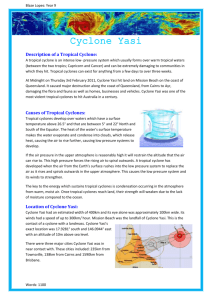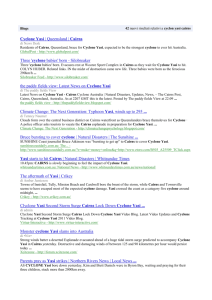Transcript - Tully state School disaster event case studies
advertisement
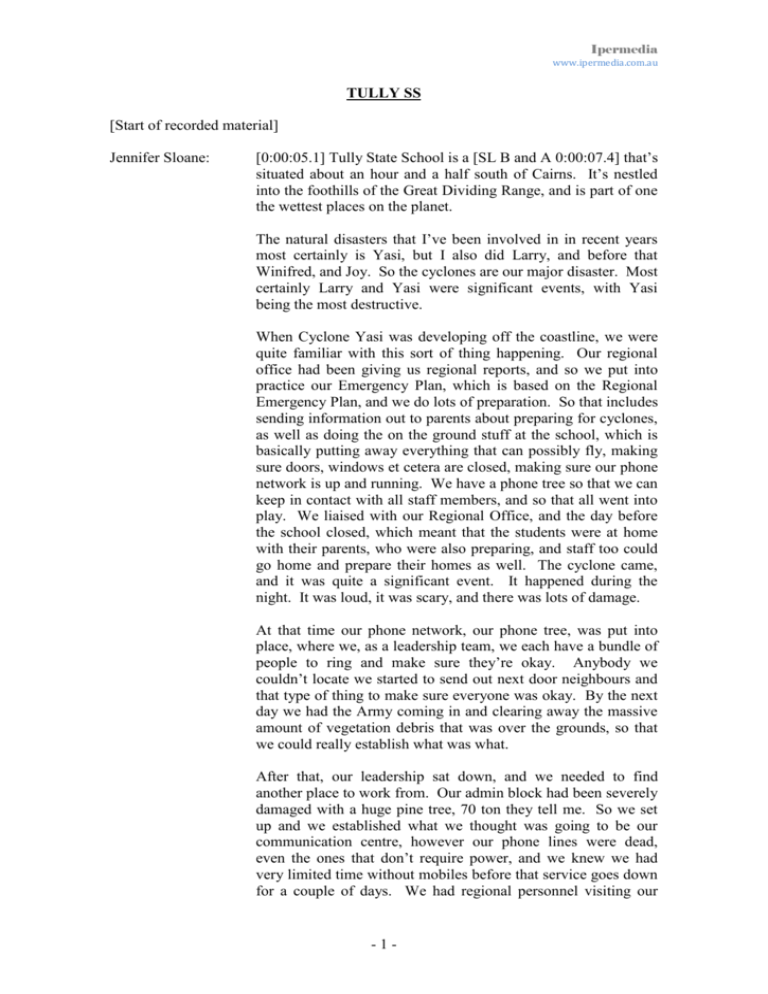
Ipermedia www.ipermedia.com.au TULLY SS [Start of recorded material] Jennifer Sloane: [0:00:05.1] Tully State School is a [SL B and A 0:00:07.4] that’s situated about an hour and a half south of Cairns. It’s nestled into the foothills of the Great Dividing Range, and is part of one the wettest places on the planet. The natural disasters that I’ve been involved in in recent years most certainly is Yasi, but I also did Larry, and before that Winifred, and Joy. So the cyclones are our major disaster. Most certainly Larry and Yasi were significant events, with Yasi being the most destructive. When Cyclone Yasi was developing off the coastline, we were quite familiar with this sort of thing happening. Our regional office had been giving us regional reports, and so we put into practice our Emergency Plan, which is based on the Regional Emergency Plan, and we do lots of preparation. So that includes sending information out to parents about preparing for cyclones, as well as doing the on the ground stuff at the school, which is basically putting away everything that can possibly fly, making sure doors, windows et cetera are closed, making sure our phone network is up and running. We have a phone tree so that we can keep in contact with all staff members, and so that all went into play. We liaised with our Regional Office, and the day before the school closed, which meant that the students were at home with their parents, who were also preparing, and staff too could go home and prepare their homes as well. The cyclone came, and it was quite a significant event. It happened during the night. It was loud, it was scary, and there was lots of damage. At that time our phone network, our phone tree, was put into place, where we, as a leadership team, we each have a bundle of people to ring and make sure they’re okay. Anybody we couldn’t locate we started to send out next door neighbours and that type of thing to make sure everyone was okay. By the next day we had the Army coming in and clearing away the massive amount of vegetation debris that was over the grounds, so that we could really establish what was what. After that, our leadership sat down, and we needed to find another place to work from. Our admin block had been severely damaged with a huge pine tree, 70 ton they tell me. So we set up and we established what we thought was going to be our communication centre, however our phone lines were dead, even the ones that don’t require power, and we knew we had very limited time without mobiles before that service goes down for a couple of days. We had regional personnel visiting our -1- Ipermedia www.ipermedia.com.au schools then on a daily basis. From there, we started to try to get our classrooms and our school safe for the return of our students as soon as possible. That was our key priority at that time. Messages out to the community were done through the radio station predominantly. We also liaised with community members, most certainly our local Police, our SES, our local Council, to make sure that we were giving our community members as much support as we could, and that we weren’t overlapping our services. The local government had houses available in Cairns by about the third day, so some of our families were actually relocated to that area, so it was really important that we got messages out to parents and children that they’re okay, they’ve just gone somewhere else, because everyone’s really wellbeing of each other. About five days, I think it was, we returned back to classes. We had no power, had no drinking water. We did have running water, which was a bonus, and we ran on generators for things like a fridge to keep milk and our medications cold. At the same time, Regional Office sent personnel down to talk with staff about their well being and how to work with the students after such a traumatic event. We also had extra Guidance Officers to work in the school to work with parents as well as the students. We did a huge evaluation of the students, assessment of the students and their well being, and kept an eye on a few who we were most concerned about. But generally speaking our kids were really resilient, and things started to go back into place, except for the heat and the water and the sausage sizzles, back into regular play within a week or two of the students coming back to school. It took longer of course to recarpet, repaint, that type of thing. We had to do an asbestos management, as we have asbestos in one of our older buildings, so parts of that building were cordoned off. We also had major leakage happening, so the power didn’t go back on for a long time in that building as well. Yearly we review our Management Plan, Emergency Management Plan, and we do that with our leadership team. This time round we have a lot of information about what worked and what didn’t work post-Yasi, and we look at that and the staff and the facilities that we now have, and on a yearly basis we walk through what we would do in preparation, the imminent disaster occurring, immediately after and the long term, and we have put things into place there upon reflection of what happened prior. -2- Ipermedia www.ipermedia.com.au We identify the relevant risks, pretty much from experience primarily, and we also use personnel from Regional Office to come and do a walk through, through the school, and identify facilities type things. As far as the well being of students and staff, we’ve done a reflective, an evaluation of what we did before, and we’ve come up with a few ideas about how we can improve that as well. So basically we look at what worked, and keep that, and then we look at what else we needed to put into place down the track, and we’re now incorporating that as well. Caroline Chadwick: [0:07:01.9] In preparation for this year’s disaster season, referring to our emergency management planning and ensuring that everybody is aware of what’s in there. The resources that we need to put in place are firstly making sure that we have enough mobile phones. That was one thing we found that communication was very lacking, so we have purchased more mobile phones. Other resources that we need to get in place is really just getting our plans ready, making sure that everybody has their communication tree, know who they need to contact, that our school grounds is as safe as possible in the event of a cyclone coming. Jennifer Sloane: [0:07:45.0] Within the school we have a leadership team, so those people are all well equipped with the knowledge about the Emergency Plan. The staff in general know the Emergency Plan, and everyone is involved in the formulation of the key communication strategies, ie the phone tree’s our primary one. Everyone is trained in how to support each other welfare wise after a traumatic event, and with the children as well. A lot of people are involved in the planning phases of organising what we need to do in such an event. The Regional Office staff most certainly are key to that, and they make contact straight up. Our local community, the Police, the Council, the local support agencies, Red Cross type of agencies, we also liaise with them to see what we can do to ensure that we’ve got things ready after the event and to do any preparation prior. I suppose the key points to being prepared for this type of event lie within communication and knowledge. Communication’s the biggest one for us. We need to communicate with the parents to let them know what’s happening. Our region always sends weather reports, even when it’s not cyclone season, about flooding, major rains, major storms, so as soon as we get that information, that gets sent to the staff. If it’s something that we think that the community need to know that they may not get from the media, we’ll actually send home a flyer. If it looks like the cyclone’s coming, we’ve got separate letters that we send home to let parents know to listen to the, which radio stations to -3- Ipermedia www.ipermedia.com.au listen to, that they’ll get all the information from those media outlets, and we usually send home a flyer to say “This is how you can prepare for the cyclone”. As far as working through drills with the children, we comply with what is required through the EQ processes of evacuation, lockdown, et cetera. With response to things like flooding and the cyclone, we also put in place on a regular basis through different ways, assemblies et cetera and class lessons, information to students about the safety issues involved in not swimming in flooded creeks, ensuring that everything’s tied down when there’s cyclones, those sorts of things, as a matter of course. Our Emergency Plan was crucial to the success that we had in managing the preparation and the recovery components of the cyclone. Without it, I think it would be very haphazard, and the fact that it lies parallel with the regional one. Central Office also offers a great resource through the ESMU, and that has lots of information that is really worthwhile for Principals who are ready to set up an Emergency Plan, to respond to an emergency, so I would highly recommend that as well. Things that worked really well was the regional network of specified personnel for us to work through, and we will actually mirror that next time in our school setting. That worked extraordinarily well. We had to, it was easier to work with one person rather than the six people underneath that person each time they came to the school. It’s interesting that the staff actually need support down the track when the insurance stuff comes through, when they need to have time off to work with the insurance or the tradespeople. Our region were very generous at an immediate response when we first opened the schools, they sent down teams of teachers who are working for us in EQ, who had volunteered to come down and replace staff members as they work through their own recovery or their own response in their individual lives, and that was really powerful and very much appreciated. The other thing that worked really well was just having the school open as soon as possible for the students. Research has shown that getting back into routine is important for everyone after such an event, and having the children back within the week, or just over a week, was massive as far as getting it done, but so, so important for the children. Additional resources that we’re going to put into place this time round really revolve around that immediate response after the cyclone, and that’s to accommodate the flood of donations and -4- Ipermedia www.ipermedia.com.au outside of school support agencies, family well being, that type of thing. We’re also going to ensure that we have communication systems up that don’t rely on phone lines going down, that type of thing. Caroline Chadwick: [0:13:06.7] The most important thing that I really felt was that we needed extra support after the cyclone, that the administration team, our leadership team, had support there beside them. The emotions that we all feel, at times we needed to just take a break, and you needed somebody with a clear head to make some decisions, because sometimes you’re just too involved in the decision emotionally. Appointing specific tasks to people, in my case for the BSM, I would make sure that I had somebody to look after resource replacement, somebody that dealt with facilities, somebody that also helped out with the student and staff support. Jennifer Sloane: [0:13:49.2] One of the key things is to get kids back to school and to have parents feel that their children are safe at school after such an event. One of the key things is the media, and spoke on ABC Radio explaining to parents what we had in place already, how the children were going to be safe, the support that the region was giving the school and the personnel and the children, and themselves if they wanted it. So basically it was through the media, and very much word of mouth, because we didn’t have access to anything like photocopying and printing et cetera until well into the weeks after the cyclone. We held meetings for people to come in and have a sausage sizzle. Everyone, when they think of cyclones here, will say “We hate sausage sizzles”, but it meant that people had a hot meal at least once a day, and it gave people an opportunity to talk, and that was really powerful. In reflection after the cyclone, we’ve put a few things into place as far as facilities and grounds to ensure that we’re not going to be slammed with a whole lot of vegetation again. So we’re very careful about what sort of plants that we put into the ground around the school, the size of the trees and the proximity to buildings. The shade cloths across the school are all able to be removed at notice, so that sort of thing is very much in place. We don’t have a lot of free flying material around the school anymore. Any that is, is able to be fit into halls et cetera, so that’s the big one. Probably the lasting impacts that we have observed include the fact that students know they can survive a cyclone. Staff know that the school will recover after a cyclone. Parents know that they can recover after a cyclone. We live in a most beautiful part of the world, where cyclones are part of the weather pattern. We are now experienced in recovering from such an event, and -5- Ipermedia www.ipermedia.com.au that gives us power, the power of knowledge, and that’s just going to make it easier should it happen again. [End of recorded material] -6-






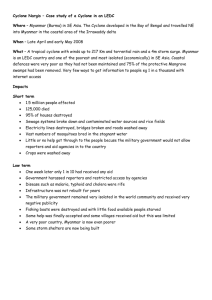
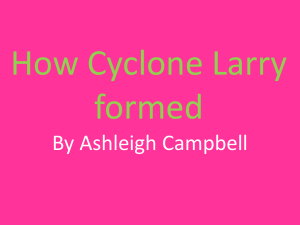

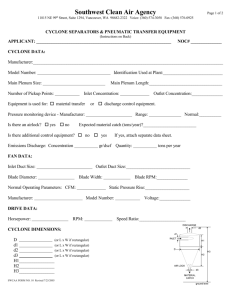
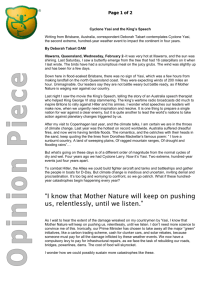
![Cyclones: Be Prepared [WORD 740KB]](http://s3.studylib.net/store/data/006800694_1-74b2a93c203c0cf133f7c52734949a31-300x300.png)
